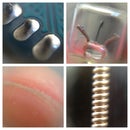Introduction: 48V Electric Flat Tracker
Step 1: The Components
We started with a Felt beach cruiser because it had the right look. We wanted a beefy bike that could fit all the components. The goal was to keep the center of gravity as low as possible. Here are the rest of the main components we purchased:
- Briggs and Stratton Etek motor (now discontinued)
- Alltrax AXE 300-amp programmable controller
- Magura 0-5K ohm twist-grip throttle
- 4 x 12V, 21Ah sealed lead acid batteries
- Avid BB7 mechanical disc brakes (160mm rotors)
- #35 moped chain
- 13-tooth drive sprocket
- 66-tooth rear sprocket
- big power switch
- 300-amp fuse
- 8 1/4 in. stainless steel motor mount (this replaces the original bottom bracket)
Step 2: Front Fork
We removed the original rigid front fork and replaced it with a Manitou suspension fork. We also bolted on an Avid disc brake set to the front end. We chose to go with mechanical discs instead of hydraulics simply because they are less expensive and less complicated. The Avid BB7's are fully adjustable. You can dial in each pad separately.
Step 3: Rear Brake Mount
Because the bike we purchased used coaster brakes (pedal backwards to stop), we had to fabricate a mount in the rear to accept our other disc brake. We used a jigsaw to cut out a piece of steel for the main shape. Next, we used a drill press to tap holes for the brake.
Step 4: Rear Hub/Sprocket
The rear hub we used is designed as a "dual disc" front hub. It has a standard mountain bike 6 bolt disc pattern on both sides. We took a blank 66 tooth rear sprocket and drilled it to accept the 6 bolt pattern. The alignment of the hub, sprocket, and disc rotor are critical.
Step 5: Rear Drive Complete
Here the brake mount is welded on, the wheels have been laced to the hubs, and on the right side, the seat stay has been crimped to get clearance from the chain and sprocket. The axle tension adjusters we used were from Answer Products.
Step 6: Motor Mount and Foot Pegs
The motor mount (cut from the same piece of steel as the brake mount) is welded into the stainless steel ring and the ring is welded into place, exactly center, replacing the original bottom bracket. The foot peg mounts are made from a couple of old work light stands welded together.
Step 7: Mount: Drilled and Welded
Centering the motor ring is very important. The ring is a section of a stainless steel light post salvaged from a scrap yard cut to 4 1/4 inches wide. It is 8 1/4 inches in diameter which leaves about a 1/8 inch gap around the motor. It is perforated on the drill press to allow air flow to the motor and notched on the right side for chain clearance. The motor mount is welded offset inside the ring for optimal motor shaft and chain placement. Mounts are welded to the underside of the motor ring to accept the removable foot peg assembly. The foot pegs themselves are aluminum BMX "grinder" pegs.
Step 8: Seat Mount
The original seat post was removed, cut short, and welded on the seat stay bridge over the rear tire and a gusset was added for strength. A rubber cap was put over the existing seat tube, and the seat clamp was flipped and reversed.
Step 9: Welding Complete
Here you can see the bike coming together. The beefy wheels and lower saddle position give it a retro look. Notice the brazed on eyelets for the rear brake cable routing.
Step 10: First Assembly
The battery trays were fabricated from aluminum stock. Each tray was then riveted together and bolted to a right and left panel. The panels are then bolted to each side of the frame. Note the power switch in the center. The right and left panels are asymmetrical to accept the terminals on the back side of the power switch. The controller is mounted upside down under the top tube with the terminals pointing backwards.
Step 11: Final Assembly
After we had finished the assembly, we had to wire it up. Within a few hours, we were testing it up and down the parking lot. It really accelerates quickly and we have not tested it for top speed. It is estimated to do better than 50 mph.
The controller we used can connect to a PC via a serial (RS-232) cable. With the freeware on their site, alltraxinc.com, you can view statistics in real time, change settings, and adjust the power curve for the throttle.
Step 12: The Maiden Voyage
Runner Up in the
Craftsman Workshop of the Future Contest













